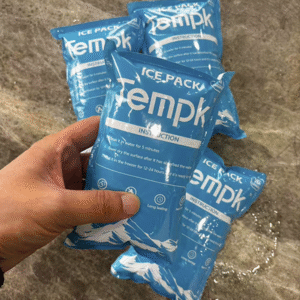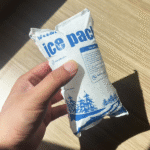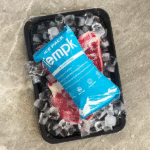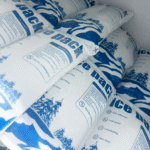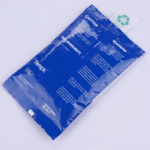Pacote de gelo seco do Canadá: A melhor solução de cadeia de frio para remessas seguras
Envio de itens perecíveis, particularly frozen goods, requires precise temperature control throughout the transit process. Pacotes de gelo seco no Canadá oferecer um eficaz, reliable solution for maintaining the ideal cold temperature. Se você está enviando produtos farmacêuticos, frutos do mar, ou sorvete, dry ice ensures that your goods remain safely frozen without the mess and complications of traditional ice. This comprehensive guide will explore the science behind Canada dry ice packs, seus benefícios, and the industries that rely on them for safe shipping.
-
What is a Canada dry ice pack, E como funciona?
-
Why is dry ice preferred over traditional ice packs in cold chain logistics?
-
What industries benefit most from using Canada dry ice packs?
-
How can you use dry ice packs safely and effectively in shipping?
What is a Canada Dry Ice Pack, E como funciona?
A Canada dry ice pack is solid carbon dioxide (Co₂), which sublimes directly from a solid to a gas, bypassing the liquid phase. This property makes it an ideal cooling solution for cold chain logistics, where avoiding liquid water and maintaining extremely low temperatures is essential. Dry ice’s sublimation point is about -78.5°C (-109.3°F), making it suitable for products that need freezing temperatures like vaccines, produtos farmacêuticos, frutos do mar, e alimentos congelados.
Why Is Dry Ice Preferred Over Traditional Ice Packs in Cold Chain Logistics?
Dry ice packs are often favored in cold chain logistics due to several key advantages over traditional ice packs. The most significant benefit is the ability to maintain ultra-low temperatures for extended periods. Ao contrário dos pacotes de gelo à base de água, gelo seco não derrete em líquido; it sublimates into gas, ensuring your products stay dry throughout the shipping process. This is especially important for products like pharmaceuticals and perishable food, where moisture can cause damage.
Here are the main benefits of dry ice:
-
Duração de resfriamento mais longa: Dry ice keeps products cold for up to 48 horas ou mais, depending on the packaging and ambient temperature.
-
Sem resíduos de água: Ao contrário do gelo, que derrete na água, gelo seco sublima em gás, ensuring no excess moisture to damage your goods or packaging.
-
Melhor controle de temperatura: The extreme cold of dry ice is perfect for shipping temperature-sensitive items that need precise control.
| Recurso | Pacote de gelo seco | Regular Ice Pack |
|---|---|---|
| Faixa de temperatura | -109.3°F (-78.5°C) | 32°F (0°C) |
| Duração do resfriamento | 24-48 horas | 6-12 horas |
| Fusão | Sublimados em gás | Derrete na água |
| Ideal para | Ultra-cold items | Itens resfriados |
Industries That Benefit from Canada Dry Ice Packs
Dry ice plays a crucial role across various industries that rely on maintaining strict temperature control during transportation. Some of the key industries include:
-
Produtos farmacêuticos: Shipping temperature-sensitive medications, Biologics, and vaccines requires constant refrigeration, which dry ice can provide for extended periods.
-
Comida e bebida: From seafood to ice cream, dry ice is perfect for keeping perishable food items frozen during transport.
-
Biotecnologia: Lab samples and diagnostic kits need consistent cold storage, making dry ice an essential tool for biotech companies.
-
Comércio eletrônico: As the e-commerce industry grows, dry ice is used for shipping frozen meals and other cold-sensitive products to consumers.
How Can You Use Dry Ice Packs Safely and Effectively?
Enquanto o gelo seco é uma excelente solução de resfriamento, safety is paramount when handling it. Here are key guidelines for ensuring safe and effective use:
Manuseio de gelo seco com segurança
Gelo seco está extremamente frio, so direct contact with skin can result in frostbite. Always use insulated gloves or tongs when handling it, and never touch it with bare hands. It’s also essential to store dry ice in a well-ventilated area to prevent the buildup of CO₂ gas, which can lead to suffocation in poorly ventilated spaces.
Packaging and Transporting with Dry Ice
Ao enviar com gelo seco, follow these essential packaging tips:
-
Use insulated containers that allow for proper ventilation to prevent pressure buildup as the dry ice sublimates.
-
Nunca armazene gelo seco em um recipiente hermético, as pressure can accumulate and cause the container to rupture.
-
Ensure there’s adequate space for the dry ice to sublimate and avoid packing it too tightly against products.
Tips for Safe Usage:
-
Use luvas ao manusear gelo seco para evitar queimaduras.
-
Ventilar storage areas to allow CO₂ to escape safely.
-
Use embalagem ventilada to ensure safe sublimation and prevent pressure buildup.
-
Maximize insulation to reduce the sublimation rate and extend the cooling duration.
Emerging Trends in Canada Dry Ice Pack Usage for 2025
As the demand for cold chain logistics continues to grow, new trends and innovations are shaping the use of dry ice in transportation. Some of the key advancements include:
Embalagem e monitoramento inteligentes
A ascensão de embalagem inteligente technologies is making dry ice shipments more efficient. New packaging systems incorporate monitoramento de temperatura em tempo real e sensores that ensure products remain within the required temperature range throughout transit.
Sustentabilidade na produção de gelo seco
With growing concerns about carbon emissions, Produção sustentável de gelo seco is becoming more prominent. Many manufacturers are focusing on producing dry ice from co₂ reciclado, significantly reducing the environmental footprint of cold chain logistics.
Automação em logística da cadeia fria
Automated systems are being integrated into the cold chain process, improving the efficiency and accuracy of packaging, carregando, e envio. These technologies help optimize the use of dry ice, ensuring it is used effectively while reducing waste.
Perguntas frequentes (Perguntas frequentes)
Q1: Quanto tempo dura o gelo seco em um contêiner de remessa?
O gelo seco normalmente dura entre 24-48 horas, dependendo da quantidade usada, a qualidade do isolamento, e a duração do envio.
Q2: É seguro enviar alimentos com gelo seco?
Sim, as long as proper packaging and safety guidelines are followed. Ensure that the shipping container is vented to allow CO₂ gas to escape.
Q3: Quanto gelo seco devo usar para minha remessa?
Como orientação geral, usar 5-10 libras de gelo seco para cada 24 horas of shipping time. Para remessas mais longas, adjust accordingly to maintain consistent temperatures.
Conclusão e recomendações
Canada dry ice packs are an indispensable tool for shipping frozen and temperature-sensitive items safely and efficiently. Their ability to maintain ultra-low temperatures without the risks of water runoff makes them ideal for industries like pharmaceuticals, biotecnologia, e comida. Seguindo as diretrizes de segurança, using the correct packaging, and staying up to date with trends and innovations, you can ensure the safe transport of your products.
PRÓXIMOS PASSOS:
-
Implement dry ice in your cold chain logistics strategy to ensure product safety.
-
Invest in proper packaging to maximize the efficiency of dry ice and prevent leaks.
-
Mantenha-se informado about new technologies and sustainability efforts to optimize your logistics operations.
Sobre Tempk
Tempk is a leading provider of cold chain logistics solutions specializing in the use of dry ice for temperature-sensitive shipments. Com foco na inovação, sustentabilidade, e conformidade regulatória, we help businesses across various industries maintain the integrity of their products during transport.
Entre em contato com Tempk hoje to learn more about our dry ice solutions and how we can help optimize your cold chain logistics!






